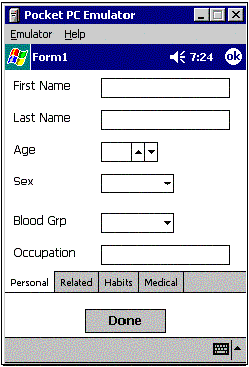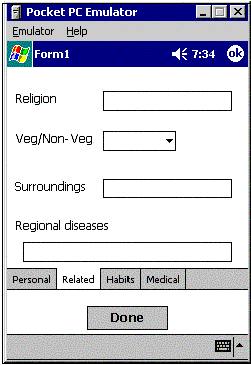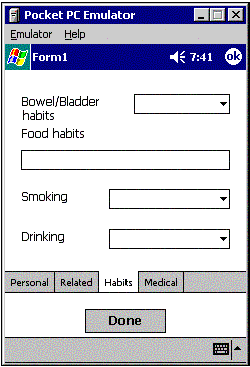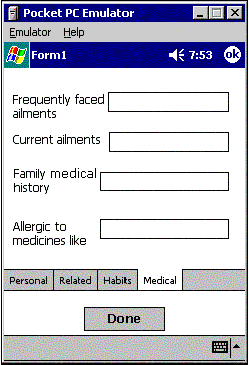What is Rural Data Capture (RDC) ?
Indian hospitals organize Village of the Month programs in which,
doctors and health officials choose a specific village for survey and collect
key health-related parameters from the villagers. Such data collected from
villages have to be consolidated and acted upon. The key challenge that the
doctors and the health officials face in this process, is the maintenance of
health records and prescriptions, for future retrieval and analysis.
Rural Data Capture (RDC) helps the hospital to capture key information
about the health conditions of people from remote, rural villages and analyze
the data more intelligently and efficiently.RDC entails the use of a Pocket PC
to gather data during surveys in villages. A medical official is presented with
a simple and easy-to-use interface on the handheld Pocket PC, using which
he/she can quickly fill out certain key details for each rural patient they
screen. This data is stored locally in the Pocket PC, and is synchronized
offline with the main database in batch mode. The data collected is later
aggregated and mined to extract descriptive information about the health
conditions of a village, and to take suitable preventive or corrective measures
against specific diseases in the area.
RDC System Design

The RDC System possesses a two-tier architecture viz. the PocketPC Front
End and the Hospital Back-End. These components are explained
below:
-
PocketPC Front End:
This component of RDC is built as consisting of the following three
sub-components:
-
RDC Data Capture Interface: The RDC Data Capture Interface provides the
necessary UI to gather indicative rural patient data. A convenient tabbed
interface, this boasts of optimal use of the limited real estate available on
the PocketPC. Screen shots of the RDC Data Capture Interface obtained on a
PocketPC Emulator are shown below:




-
Rural Data SQL Server CE Database: The Rural Data SQL Server CE Database
is an efficient local store on the PocketPC, of the information obtained on the
RDC Data Capture Interface. It comprises a single table called RuralData
with a schema suited to store indicative rural patient data. SQL Server CE
makes application development easy while providing a consistent development
model and API. It is also a robust, feature-rich mobile database solution with
a relatively small footprint. It includes a query processor, merge-replication
and synchronization capabilities.
-
SyncRDC XML Web Service Client: In order that the patient data stored in
the Rural Data SQL Server CE Database be meaningfully analyzed and subsequent
treatment to villagers be provided, it is necessary that this data be
synchronized with the Patient Information System of the hospital. RDC provides
a mechanism for this purpose through a simple XML Web Service made available on
the hospital server (as we shall discuss soon). The SyncRDC Web Service Client
is a client of this XML Web Service and runs on the PocketPC. In batch mode,
the PocketPC can dial up to the Internet, make a call to the XML Web Service
running in the hospital servers and upload the rural patient data.
-
Hospital Back-End:
This component of RDC is built as consisting of the following two
sub-components:
-
Sync RDC XML Web Service: As mentioned earlier, RDC provides a
XML Web Service based solution for synchronizing rural patient data gathered on
the PocketPC with the Hospital Patient Information System. Sync RDC XML Web
Service is the XML Web Service which runs on the hospital server and enables
the PocketPC to upload the rural patient data.
-
Hospital SQL Server Database: The Hospital SQL Server Database is
persistent store at the hospital site which houses the data for the Patient
Information System. The rural patient data obtained from the PocketPC is stored
in this database for further analysis by the doctors. Once the data is
analysed, suitable treatment is offered to the villagers.
Summary
Thus RDC helps the hospital to capture indicative rural patient data in
a simple and quick manner. The locally stored data is easily synchronized with
the Hospital Patient Information System through a XML Web Service. The data
collected is saved to persistent storage for further analysis and suitable
treatment is offered to the villagers. The data can also be mined to gauge the
overall health conditions of a village or presence of regional diseases etc and
appropriate preventive or corrective measures can be taken.
|





